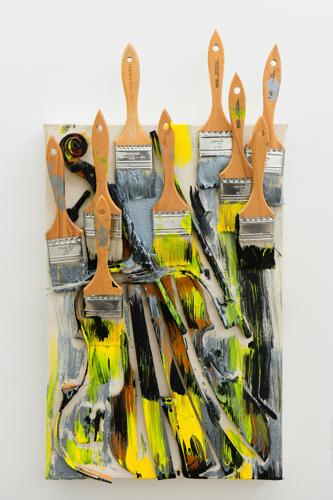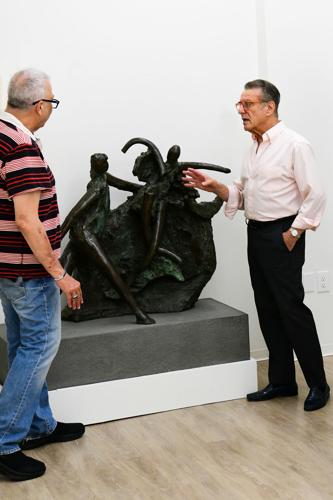At first glance masters will share the space with a sweeping range of 19th- to 21st-Century artists including Max Klinger, Alison Saar and Ed Ruscha.
Patrons can get an up-close look at the sculptures of more than 30 artists created over a 125-year period and collected by Jack Rutberg, the gallery founder and owner. After more than 38 years on La Brea Avenue in Los Angeles, the gallery relocated to Pasadena in 2022.
Rutberg said this current exhibition feels, in many ways, like a narrative of his life.
“There are works in this exhibition that I’ve owned for 50 years and some I acquired just recently,” Rutberg said. “I am the example of the thrill of living with art. It doesn’t have to be on an academic level or the deadly serious aspects of collecting. Anyone who owns anything is a collector.”

Francisco Zúñiga (1912-1998) – Coloquio, 1979 – Bronze (Rich Schmitt/Pasadena Weekly Staff)
With this exhibition, “Sculptors: From Degas to Ruscha,” Rutberg hopes to show that collecting art isn’t reserved for the wealthy — and that anyone can enter the world of collecting. Media attention on record-breaking sales, Rutberg said, can leave people feeling excluded from the art world.
“I celebrate the joy of being in the presence of these astounding and humbling creations,”Rutberg said.
“We’ve brought people to their knees on occasions as they engage with something they were unprepared for. That’s magic.”
The exhibition serves as a sanctuary of sculptural discovery, showcasing renowned artists from the past century alongside lesser-known talents whose work deserves greater attention.From a 6-foot bronze masterpiece by Francisco Zúñiga to a delicate 6-inch piece by Pierre Bonnard, the exhibition reveals the breadth and depth of artistic expression.
“The criteria are always that it is work I respect,” Rutberg said. “When you champion something, you have to believe in it, to believe that it is meaningful. This exhibition really is a compilation of decades of discoveries.”
Rutberg emphasized that the discoveries vary in size and spirit—some are monumental, others are quiet moments of revelation.
“For me, there’s no hierarchy,” Rutberg said. “It isn’t amatter of dollars and cents, or periods and sensibilities. It’s all about the integrity of the work.”
The exhibition spans the modern period. One piece is Gauguin’s two-sided sculpture of Tahitian subjects; another is one of only two bronze sculptures by Ed Ruscha that incorporates his iconic wordplay.
Rutberg also highlights a bronze bas-relief by Käthe Kollwitz, one of only 19 sculptural works by the famed German artist.

Arman (1928-2005) – Untitled, 1997 – Assemblage on Canvas (Rich Schmitt/Pasadena Weekly Staff)
“Kollwitz was, in my view, perhaps the greatest 20th century woman artist,” Rutberg said. He noted that while the Nazis once banned her from exhibiting, Germany now has two museums dedicated to her legacy.
“Los Angeles has a great history because of all the European immigrants who came here to evade the war and brought their Kollwitz works, because she was an artist of the people.”
The new Pasadena gallery offers a more intimate experience than the former Downtown location, encouraging slower, more personal engagement with the work.
“Everything gets a different level of consideration,” Rutberg said. “You move from work to work and each one commands your attention. The public coming to see this exhibition has a unique opportunity. Generally speaking, when people think of sculpture, they think in terms of monument, of institutions. But these are objects that the artists engaged intimately. They’re meant to be intimately held and are on a scale to be lived with.”
Rutberg didn’t curate this exhibition around a central theme. Instead, it emerged from decades of collecting. His goal, he said, was to honor the work—and the viewers. In arranging the pieces, he discovered numerous connections and dialogues between the artists. One example is a large 1979 bronze by Francisco Zúñiga placed just a few feet from a 1905 sculpture by Aristide Maillol.
“Here’s Zúñiga, who was a great admirer of Maillol, and they were achieving the same things—distilling form to silence and dignity,” Rutberg said. “Just between the two at right angles, there’s a Gauguin bronze. (Maillol’s hero) was Gauguin and Zúñiga greatly admired Gauguin—in 1930, he did a woodcut portrait of him. So the connections are profound.”
Rutberg encourages patrons to explore the relationships between the sculptors and to engage in conversations about how they inspired each other.
Another notable pairing places sculptures by Alison Saar and Ed Ruscha side by side. Ruscha’s piece is a bronzebillboard with cut-out lettering, while Saar’s depicts a spade bearing the face of a named, formerly enslaved person who helped build the country.
“(Ruscha’s) light-hearted play on words and absurd sort of signage next to Alison Saar, who is dealing with the African diaspora with this spade. It’s charged with poignancy,” Rutberg said. “Seeing them together, both created with conviction, are two sides of a coin that are very much part of Los Angeles and what Los Angeles represented in history.”

Jack Rutberg confers with customer Tim Misenhimer about exhibit pieces. (Rich Schmitt/Pasadena Weekly Staff)
Rutberg has already felt the excitement of patrons since the exhibition’s preview reception on June 29. One newcomer to the gallery told him she’d just returned from New York where she’d spent a day at the Museum of Modern Art.
“She says, this is as compelling as anything I’ve seen there,” Rutberg said. “How thrilling for me to hear that from people. I’m so proud of the small passages in this exhibition that people come here and discover.”
Rutberg said he takes great joy in how surprised people are at the breadth of the exhibition and that all the works are from his holdings.
“I really think this is the exhibition of the summer,” Rutberg said. “The show offers any museum curator or beginning collector or student an opportunity to engage — and that’s the thrill.”

